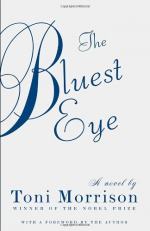|
|
The Bluest Eye Topic Tracking: Culture
Culture 1: Mr. Henry moves into Claudia and Frieda's house. One day, the girls come home and when they walk in Mr. Henry greets them. He flatters them by telling them they look just like Greta Garbo and Ginger Rogers, two white American female actresses. These two actresses represented American society's ideal beauty, with their blonde hair and blue eyes. They, and other actresses like them, were so idealized by the media that it forced young American girls, both white and black, to question their own beauty if it differed from the standard of blond hair and blue eyes.
Culture 2: After seeing the cup with Shirley Temple on it, Claudia explains her ill feelings for her. Shirley Temple was the epitome of what all of America adored in little girls: her bouncy blonde curls and big blue eyes. This sickened Claudia, as she was so different from Shirley Temple and all of the other little girls who looked like Shirley.
Culture 3: Claudia tells the story about the doll she received for Christmas one year. This doll was a beautiful doll that had blonde hair, blue eyes, and pink skin. Instead of appreciating the doll like most other children would have done, Claudia dismembered and destroyed the doll. She was sick of having American ideals of beauty placed on her, which said that being white with blonde hair and blue eyes was what was deemed as beautiful.
Culture 4: This excerpt from a first grade reading primer describes the perfect white family. Morrison uses these excerpts in many points of the story to illustrate the dichotomy between the ideal white family, and the family of blacks, specifically Pecola's family. The reading book perpetuates the stigma that what is seen as "ideal" in American culture means having a neat little house, run by two loving parents, with two children, one of which has blonde hair and blue eyes, and a fun loving dog who plays with the children. This social stigma presses on children who are "different" that are reading these books, and makes them think they are abnormal and unacceptable.
Culture 5: The Breedloves are described. They think they are poor and ugly, and it says that much of the reason they think this is because of the white American media. The media, as part of our culture, sets the standards for what defines beauty, and anything straying from these standards is viewed as ugly.
Culture 6: Pecola is constantly faced with the standards set on her society by American culture. She cannot even enjoy a piece of candy without feeling that she is different and lacking in some way in terms of beauty. When she goes to eat her Mary Jane candy, she is mesmerized by the little girl of Mary Jane on the cover, a blonde-haired, blue-eyed girl. These cultural pressures of what defines beauty make Pecola aware of just how much she strays from that defined beauty. This eventually leads to her desire for blue eyes, which in turn leads her into madness.
Culture 7: When Pecola, Maureen, Claudia and Frieda are walking home from the ice cream shop, they pass a theater with a picture of Betty Grable on it. Young girls are bombarded with American culture's ideals of beauty, such as pictures of famous actresses. Betty Grable in particular, with her blonde hair and blue eyes, makes Pecola and Maureen want to look like her. However, despite all of their hopes and wishes, they will never be able to look like that, and they are left as the victims of a culture that standardizes and limits young children.
Culture 8: During her younger years, Pauline Breedlove spent a lot of time at the movie theater. It was here where she learned American standards of true beauty. Constantly faced with actresses like Jean Harlow, the ultimate Hollywood blonde bombshell, Pauline was forced to examine her own beauty in terms of Harlow's. She realized that she did not look anything like Harlow, and based on this, came to the conclusion that she must be ugly. However, her feelings of ugliness were purely based on cultural standards set on her through the medium of Hollywood.
Culture 9: Claudia feels the need for Pecola's baby to be alive and healthy. She wants the baby to survive because she wants to counteract the cultural emphasis placed on white girls with blonde hair and blue eyes, exemplified by the types of white baby dolls most children adore (dolls that look like Shirley Temple). If Pecola's baby lives, maybe people can learn to love a black baby and see black as beautiful too. At least this is what Claudia is hoping for.
Culture 10: Pecola beats her arms like a bird, and attempts to fly up to the sky. However, she cannot. The reason she cannot is because she has been held back by the culture in which she lives, a culture that values white beauty, and ignores black beauty. It was an inevitable end result that Pecola would never be able to achieve the standards of beauty she wanted to. She was born a black child, and unfortunately, her culture does not accept black beauty. Thus, her dreams would never be fulfilled. And even though she thinks she has blue eyes, the world around her does not recognize her as she wishes to be seen. And because of this, she is driven to madness, caused by the pressures and social standards of her culture.




